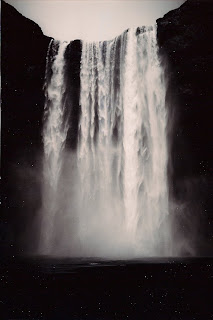 A quick apology for being off the air for a month. When I'm not chasing a toddler I'm sleeping as I near my due date with my second child. But recent geologic events in Iceland have grabbed enough of my attention to get me off the couch, back online and reminded me on this Earth Day that Mother Nature really is in charge.
A quick apology for being off the air for a month. When I'm not chasing a toddler I'm sleeping as I near my due date with my second child. But recent geologic events in Iceland have grabbed enough of my attention to get me off the couch, back online and reminded me on this Earth Day that Mother Nature really is in charge.For those of you who have been reading this blog for a while you know I'm a science geek. Nothing is cooler than an erupting volcano. Especially an erupting volcano that I've been to! In April of 2001 a friend and I took a long weekend adventure to Iceland, and it was one of the most beautiful places I have ever been. Now that the ash is clearing, and air traffic resumes to this magical land, I recommend everyone to go visit. You won't be disappointed.
My friend and I spent a day driving all over southwestern Iceland which brought us right past the Myrdalsjokull and Eyjafjallajokull glaciers on our way to Vik, a beautiful black sand beach at the southern tip of the island. The only picture I have of the volcano area is of the Myrdalsjokull glacier (below), which on the map above looks like it's the same piece of ice as Eyjafjallajokull.
 And under the Eyjafjallajokull glacier is the current erupting volcano.
And under the Eyjafjallajokull glacier is the current erupting volcano.There's a million things you can find online about this volcano, besides of course the air traffic disruptions (ironically the ash from Eyjafjallajokull kept my Icelandic travel partner from returning from Boston to her teaching job in Russia, she just made it back today, five days late). But there are a few fascinating things I've learned about this eruption:
The first is that it could go on for a year or more. And when Eyjafjallajokull erupts if often sets off the neighboring volcano of Katla, which is three times bigger. So if you're planning any air travel to or from Europe anytime soon you may want to buy travel insurance.
Secondly, as the glacier melts from the volcanic activity it releases pressure on the earth's crust which usually results in more volcanic activity. Scientists are predicting that with global warming we'll see more volcanoes. The Times UK reports that "...the eruption may be only a taste of the future if climate change causes ice sheets to melt further. As the last ice age ended, volcanic activity in Iceland increased 30-fold because of reduced pressure on the earth’s mantle."
And third, the volcano is probably releasing enormous amounts of fluoride, which could possibly poison livestock that might drink from glacial melt water. Wikipedia reports "In 1783, 79 per cent of the Icelandic sheep stock were killed, probably as a result of fluorosis caused by the eruption of Laki. The effect also spread beyond Iceland. Ash from the current Eyjafjallajökull eruption contains one third the concentration typical in Hekla eruptions, with a mean value of 104 milligrams of fluoride per kilogram of ash." That toxic ash that is currently spreading all over Europe.
So for those of you who just thought a little ash was affecting air travel and nothing else, this volcano is doing a lot more than even I realized.
 I'll leave you with a few photos snapped back in 2001 with, believe it or not, print film. Luckily I have a scanner.
I'll leave you with a few photos snapped back in 2001 with, believe it or not, print film. Luckily I have a scanner.To the left is Skogafoss, one of the most amazing waterfalls I have ever seen and very close to the Eyjafjallajokull volcano. To fully see its size that's me below in front of it.

This photo below was taken literally standing in the zone between the American and European techtonic plates. All those sea stacks are old volcanoes. If you look out to sea from this spot old volcanoes dot the horizon all the way south.














